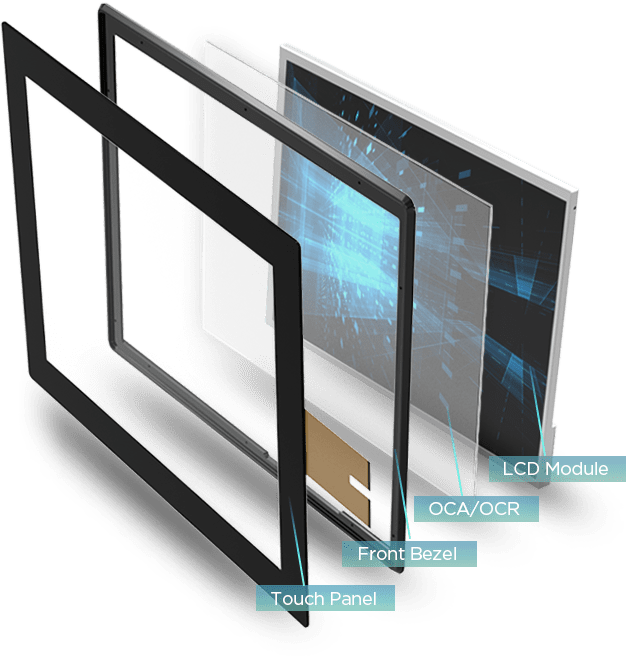In this digital age, capacitive touch screens have become ubiquitous, revolutionizing how we interact with electronic devices. A critical aspect of their functionality lies in the integration of Optically Clear Adhesive (OCA) and Optical Character Recognition (OCR). So this article explores the synergistic relationship between OCA and OCR, examining their individual roles and the collective impact they have on advancing touch screen technology.
1.1 What is OCA?
Optically Clear Adhesive, commonly known as OCA, is a transparent and optically matched adhesive layer used in capacitive touch screens. Its primary purpose is to bond different layers of the screen while maintaining optical clarity.
1.2 OCA’s role in touch screen technology
OCA plays a crucial role in enhancing display clarity by minimizing light reflection and increasing the overall brightness and contrast of the screen. Its adhesive properties ensure a secure bond between layers, contributing to the durability of the touch screen.
1.3 Benefits of OCA in capacitive touch screens
The benefits of OCA extend beyond clarity, encompassing improved touch sensitivity, resistance to environmental factors, and increased overall robustness. Its application has become integral to achieving optimal performance in modern touch screen devices.
2.1 What is OCR?
Optical Character Recognition, or OCR, is a technology that converts different types of documents—such as scanned paper documents, PDFs, or images captured by a digital camera—into editable and searchable data.
2.2 OCR’s significance in touch screen technology
In the context of touch screens, OCR enhances functionality by enabling the recognition and interpretation of written or printed characters. This capability opens the door to diverse applications, from translating text to facilitating seamless data input through handwriting recognition.
2.3 Applications and advantages of OCR in capacitive touch screens
OCR’s applications in touch screens range from document scanning and language translation to text input methods. The advantages include improved data accuracy, accessibility features for diverse user needs, and expanded possibilities for information processing on touch-enabled devices.
3.1 The need for integration
The integration of OCA and OCR arises from the complementary nature of their functions. OCA ensures optimal clarity for OCR processes by minimizing distortions caused by uneven surfaces or reflections.
3.2 OCA and OCR working together
When OCA and OCR work together seamlessly, the touch screen not only displays content with clarity but also accurately recognizes and processes written or printed information. This integration enhances the overall precision and responsiveness of the touch screen.
3.3 How integration enhances touch screen performance
The synergy between OCA and OCR results in improved touch screen performance, offering users a more intuitive and efficient experience. So the combined efforts reduce interference, providing a smoother surface for touch interactions and enhancing the accuracy of character recognition.
4.1 OCA advancements
Ongoing advancements in OCA technology focus on refining its adhesive properties, durability, and compatibility with various screen materials. These improvements contribute to an extended lifespan and enhanced performance of capacitive touch screens.
4.2 OCR advancements
Advancements in OCR technology revolve around increasing recognition accuracy, expanding language support,however, incorporating machine learning for context-aware character interpretation. These developments lead to more versatile and adaptable OCR applications.
4.3 Combined advancements and their impact on touch screen devices
The collective progress in OCA and OCR advancements significantly impacts touch screen devices. Users can expect devices with clearer displays, improved touch sensitivity, and enhanced character recognition capabilities, opening doors to new possibilities in user interactions.
5.1 Emerging trends in OCA and OCR integration
Future trends in OCA and OCR integration may involve further optimization for flexible and foldable screens, enabling innovative form factors while maintaining optical clarity and recognition accuracy.
5.2 Potential applications of integrated touch screen technology
Integrated touch screen technology holds promise in diverse applications, such as augmented reality interfaces, advanced data input methods, and enhanced accessibility features for users with different needs.
5.3 Challenges and opportunities for further development
As technology progresses, challenges such as minimizing power consumption, refining recognition algorithms, and addressing privacy concerns will require attention. Successfully navigating these challenges will unlock new opportunities for the development of even more sophisticated touch screen solutions.
The integration of OCA and OCR in capacitive touch screen technology represents a harmonious convergence of clarity and functionality. As these components continue to evolve, so too will the landscape of touch screen devices, offering users an immersive, responsive, and visually stunning interaction experience. The future holds exciting prospects as technology advances towards new heights of innovation in the touch screen industry.

DINGTOUCH is a company specializing in the R&D and production of touch screen technology, headquartered in Shenzhen, China. However, as a professional touch screen supplier, DINGTOUCH commit to providing high-quality, stable and reliable touch screen products to meet the diverse needs of customers. Also We continue to carry out technological innovation and product optimization to ensure that its touch screen products have good sensitivity, accuracy and durability.
In addition to the products themselves, we also focus on cooperation and communication with customers. However, commit to providing customize solutions and excellent after-sales services. Through continuous efforts to improve product quality and customer satisfaction. So we have established a good reputation in the touch screen industry and won widespread market recognition.
PCAP maximum size 65”
Multi-touch
Optical bonding service/air bonding
LCD interface: HDMI/RGB/MIPI/LVDS/EDP, etc.
PCAP interface: IIC/USB interface
Also CTP can customize the cover glass surface treatment process AG (anti-glare), AR (anti-reflection), AF (anti-fingerprint), waterproof, and glove touch
Supports 0.55 mm-12 mm coverslip touch.
Support operating temperature: -40℃-90℃.
We as a professional customized touch screen manufacturer with more than 13 years touch screen experience. So we are welcome to customize your capacitive touch screen . So that here are some of our standard product . Such as 7 inch touch screen, 10.1 inch touch screen ,15 inch touch screen,15.6 inch touch screen,17 inch touch screen,17.3 inch touch screen,18.5 inch touch screen,19 inch touch screen,21.5 inch touch screen, 23.6 inch touch screen,23.8 inch touch screen,27 inch touch screen.Contact our team today to buy a capacitive touch screen are best for our retail business needs.
our other one website: www.szdingtouch.com